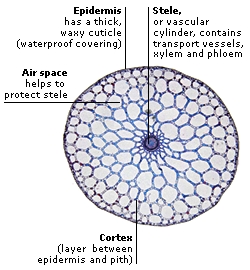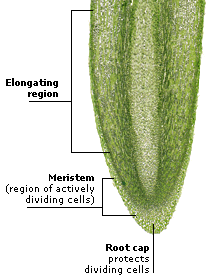DK Science: Plant Anatomy
A plant’s body has different structures designed for different tasks, such as making food and conserving water. LEAVES, usually broad and flat, take in energy from sunlight and carbon dioxide from the air. ROOTS snake through the soil to take in water and minerals. The STEM supports the part of the plant above ground. It contains a network of microscopic tubes that transport essential water, minerals, and food between the roots and the leaves.
A plant is made up of microscopic living structures called cells. Like animal cells, plant cells have a nucleus and an oily membrane surrounding the whole cell. A plant cell is also encased in a tough cell wall and usually contains a large, fluid-filled bubble called a vacuole. Cells of green plant parts also contain chloroplasts.
Leaves trap carbon dioxide and sunlight to make food by photosynthesis, but lose water from their surface. Larger, flatter leaves produce more food but lose more water. In dry habitats, leaves have specialized shapes and a waxy covering, to limit the amount of water loss.
The simplest type of leaf consists of a flat blade, but some leaves are divided into smaller “leaflets”. These compound leaves may offer certain advantages, such as less resistance to the wind. Leaves of evergreen plants, such as camellias, are often extra waxy to protect against drought.
The stem is the main support of the upright plant, and connects the roots and leaves. It contains bundles of microscopic tubes – xylem vessels, carrying water and minerals, and phloem vessels, carrying food. The stem also has cells with special thickened walls that help to provide strength. It may have layers of dividing cells, too, that allow the stem to grow thicker.

Different plants arrange their vascular tissue (bundles of transport vessels) differently. In the stem of the mare’s tail plant, xylem and phloem run through an inner cylinder of large cells, called a stele. Around this is a light, protective cortex of air-filled spaces. The stem’s outermost cells have a waxy coating to stop the stem from drying out.
A plant’s roots hold it firmly in the soil and also take up water and minerals. Some types of plant have one main root, called a taproot, with smaller lateral (side) roots branching off. Other plants have root systems that form a dense tangle. Long taproots allow the plant to gain water from greater depths, but a thick network of roots may provide a more robust anchor in the soil.

The core of a root, known as the stele, contains the transport vessels. The xylem vessels carry water and dissolved minerals that have been taken into the root from the soil up to the rest of the plant. The phloem vessels bring essential sugars, giving the root the energy it needs to take up more minerals and also to grow.
Root tips produce substances that make roots grow down. The root cap secretes slime so that the growing root can slip through the soil. The region immediately behind the root cap is called the meristem and contains the actively dividing cells. The newly divided cells grow longer, lengthening the entire root as it grows downwards.

